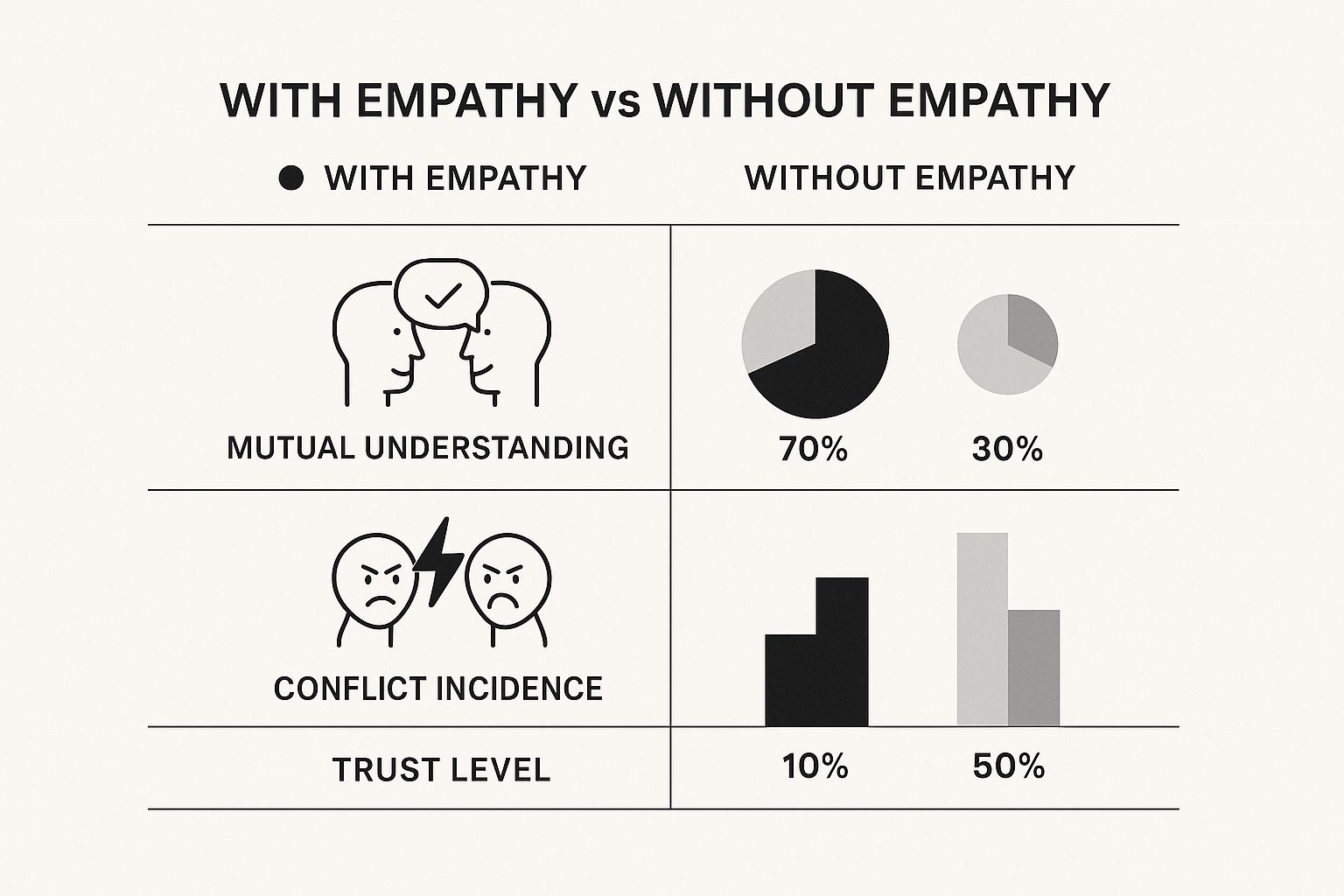Create Your Own AI Girlfriend 😈
Chat with AI Luvr's today or make your own! Receive images, audio messages, and much more! 🔥
4.5 stars

Ever wonder what makes someone a truly great conversationalist? It's not about being the loudest person in the room or having a list of witty one-liners. The real secret is much simpler and more authentic. It all comes down to mastering a few core skills: engaged listening, understanding body language, and asking questions that actually mean something.
Great conversationalists aren't born that way—they're made. These skills are your blueprint for building real, lasting connections.
The Real Foundation of Great Conversations

Learning how to improve your conversational abilities is less about finding the "perfect" thing to say and more about creating a space where a genuine connection can flourish. It's a fundamental shift from performing to participating. Too often, we treat conversation like a verbal tennis match, just waiting for our turn to hit back with a clever response. But the truth is, the most memorable and meaningful discussions are built on a much deeper foundation.
Why These Skills Truly Matter
This isn't just about dodging awkward silences at your next social gathering. Strong communication is a life-changing skill. Professionally, it’s what sets you apart. In fact, research for 2025 shows that 57% of employers worldwide see communication as the most sought-after skill in new hires. Recruiters specifically prioritize verbal communication (55%) and active listening (36%) above many other technical qualifications.
This power translates directly into your personal life, too. It’s the key to moving beyond small talk and building relationships with real substance. When you learn to truly listen and respond with genuine curiosity, you make people feel seen, heard, and valued.
Before we dive into the "how-to," let's quickly summarize these core conversational pillars. Think of these as the essential building blocks for any meaningful interaction.
Pillars of Effective Conversation
| Skill | What It Means | Why It Matters |
|---|---|---|
| Active Listening | Going beyond just hearing words to understand the speaker's intent, emotion, and context. | It shows respect, builds trust, and ensures you're responding to what's actually being said, not just waiting for your turn to talk. |
| Nonverbal Cues | Paying attention to (and using) body language, eye contact, and tone of voice to add layers of meaning to the conversation. | These cues often reveal more than words alone. Mastering them helps you read the room and convey your own feelings more accurately. |
| Thoughtful Questions | Asking open-ended questions that invite stories, opinions, and deeper reflection, rather than simple "yes" or "no" answers. | This is how you turn a simple exchange into a dynamic, engaging dialogue. It shows you're genuinely interested in the other person. |
By focusing on these three areas, you're not just learning to talk better; you're learning to connect better.
Your Path to Better Conversations
So, where do we go from here? Think of the next sections as your practical roadmap. We’re going to break down exactly how to:
- Become a master listener: We’ll move past just hearing words and get into understanding the real meaning and emotion behind them.
- Decode nonverbal cues: You’ll learn how your body language and tone can speak volumes, often more than your words.
- Ask powerful, open-ended questions: Discover how to spark fascinating discussions instead of getting stuck with one-word replies.
If you want a safe space to practice these new skills without any pressure, conversational AI platforms can be an incredible training ground. For example, you can try out new techniques and build confidence with an AI girlfriend before you take your skills out into the real world.
Become a Better Listener Starting Today

Here’s a truth that took me a long time to learn: powerful conversations aren't about what you say, but how well you listen. It's so easy to fall into the trap of just waiting for our turn to talk, mentally rehearsing our next line while the other person is still speaking.
To really connect, you have to shift from just hearing words to active listening.
This isn't just about being quiet. It's about fully engaging with the speaker's ideas, their emotions, and what they're saying between the lines. It’s the secret sauce that turns a forgettable exchange into a genuine connection. You’d be surprised how rare this skill actually is.
In fact, one 2023 communication study found that a staggering 91% of employees believe their leaders lack crucial communication skills. A big part of that is mistaking hearing for listening and failing to show you're actually interested.
Putting Active Listening Into Practice
So, how do you actually do this? It boils down to small, deliberate actions that prove you’re present and tuned in.
Let's say a friend is venting about a rough day at work. Your first instinct might be to jump in with advice. Don't. Instead, try paraphrasing what you're hearing.
"Wow, it sounds like you felt totally overlooked when your boss didn't even mention all your work on that project. I can see why you’d feel so disheartened."
See the difference? This simple act of reflecting their feelings back to them shows you get it. It validates their experience and proves you were listening—not just waiting to speak.
Another fantastic tool is the clarifying question. Imagine you're at an event and someone says they work in "fintech." A passive listener would just nod and smile. An active listener gets curious.
- "That's interesting! What part of the fintech world are you most excited about right now?"
- "What's the biggest challenge you're seeing in that space at the moment?"
These kinds of questions do more than just fill the silence. They signal real curiosity and turn a simple chat into a memorable dialogue. This is how you build rapport and trust, one thoughtful question at a time.
Speak Volumes Without Saying a Word

It’s easy to get caught up in finding the perfect words, but a whole other conversation is happening simultaneously—one that’s completely silent. This dialogue unfolds through your posture, the look on your face, and the sound of your voice. If you want to get better at conversation, you have to get a handle on these nonverbal cues. They often broadcast what you’re really thinking, whether you mean to or not.
Think about it. You can tell someone, "I'm completely tuned in," but if you're glancing at your phone or fidgeting, what message are you actually sending? Your actions are shouting over your words. It’s this disconnect that can either build a bridge or throw up a wall between you and the person you're talking to.
This isn’t just a hunch; the data backs it up. The well-known 7-38-55 model breaks down how we receive messages. It suggests that a mere 7% of meaning comes from the words themselves. The rest? A whopping 93% is nonverbal: 38% from your tone and 55% from your body language. You can dig deeper into these communication statistics on passivesecrets.com.
Projecting Confidence and Openness
So, how do you make this work for you? It starts with your physical presence.
Adopting an open posture is ground zero. Keep your arms uncrossed and turn your body toward the person you're speaking with. It’s a simple, almost universal signal that says, "I'm here, I'm open, and I'm listening."
Next up is eye contact. The goal isn't to stare someone down, which just feels aggressive. A great technique is the "triangle method"—letting your gaze shift naturally between their eyes and their mouth. It shows you're engaged without being intimidating.
Finally, don't forget your voice. The exact same sentence can come across as genuine or dripping with sarcasm, all depending on your pitch and inflection.
Key Takeaway: By consciously using a warmer, more engaging tone, you make yourself more approachable. This simple shift helps your words land with the right emotional weight, building a connection that feels real and authentic.
Ask Questions That Spark Great Conversations
Have you ever felt a conversation fizzle out after just a few exchanges? The culprit is often the type of questions we ask. Good questions are the lifeblood of a memorable chat, but many of us fall back on closed questions—the kind that only need a "yes," "no," or single-word reply. To really connect, you need to master open-ended questions.
Think of these questions as an invitation. You’re not just asking for a fact; you’re asking for a story, an opinion, or a feeling. This simple shift can turn a dull Q&A session into a genuine, shared experience where you’re not just talking at someone, but exploring ideas with them.

When you lead with curiosity and empathy—the foundation of a great question—you build trust and understanding almost instantly. As you can see, the data backs this up, showing that empathetic conversations dramatically reduce conflict and increase connection.
How to Frame Better Questions
Making the switch from closed to open-ended questions is easier than it sounds. It’s all about swapping out questions that start with 'did you' or 'do you' for ones that start with 'what,' 'how,' or 'why.' This small tweak makes a world of difference.
A great way to practice this is with an AI, where the stakes are low. When users begin asking more thoughtful questions, they often find the interactions become surprisingly rich and rewarding. You can see this principle in action and sharpen your skills by experimenting with something like an AI girlfriend API.
A great question is a gift. It shows you’re not just waiting for your turn to speak; you’re genuinely invested in understanding the other person’s world. This is where real connection happens.
To make this crystal clear, let's look at how you can transform common, conversation-killing questions into ones that open the door to a real discussion.
Transforming Your Questions
| Instead of This (Closed Question) | Try This (Open-Ended Question) |
|---|---|
| "Did you have a good weekend?" | "What was the most interesting part of your weekend?" |
| "Do you like your job?" | "What's the most surprising thing you've learned in your work?" |
| "Was the movie good?" | "What did you think of the ending? Anything you would have changed?" |
See the difference? These kinds of prompts give the other person the space to share more of who they are. You’re not just getting a simple answer; you’re getting a piece of their experience, turning a basic chat into something far more memorable.
Navigating Conversations in the Digital World
So much of our daily life happens on a screen now, doesn't it? We've traded conference rooms for video calls and casual chats for instant messages. But here’s the tricky part: the rules for great digital conversation are still being figured out. It’s incredibly easy for things to get lost in translation.
A short email can come off as aggressive, or looking away from your screen for just a second during a video call can make you seem totally checked out. These little digital missteps can create friction where you're actually trying to build a connection.
Without body language and tone of voice, we're missing huge pieces of the communication puzzle. This means we have to be much more intentional with our words and actions online.
Mastering Your Digital Presence
The real secret is learning to compensate for what's missing. Since your tone of voice can't be heard in a text message, try using an emoji to add a little emotional flavor. It's amazing how a simple smiley face can soften a direct statement and make it feel more friendly.
When you're on a video call, your on-camera presence is everything. Make an effort to look directly into the camera, not just at the faces on your screen. Leaning in slightly also sends a powerful signal that you’re locked in and listening.
It's so easy for messages to get wires crossed online. A great habit to build is simply acknowledging what people say. Even a quick "got it" or "thanks" keeps the conversation flowing and confirms you're on the same page. It’s a small thing that builds a lot of trust.
If you want a fantastic, low-stakes way to sharpen these skills, try practicing with AI. Chatting with an AI chat partner gives you a safe space to play around. You can work on writing with more clarity or experiment with new ways to express yourself, all without the pressure of a live audience. It’s a brilliant way to build confidence before taking your new skills into your work or personal life.
Your 7-Day Action Plan for Better Conversations
Let's get practical. Real improvement in conversation skills doesn't happen by memorizing rules; it comes from putting simple ideas into practice, over and over, until they feel natural. This is where we shift from theory to action with a straightforward plan you can start today.
Everything we’ve covered—active listening, reading nonverbal cues, and asking great questions—works together. Think of them less as a checklist and more as ingredients in a recipe. When you combine them, you create something much more interesting. The key is to start small and recognize that every single conversation, whether on Luvr AI or at the coffee shop, is a chance to practice.
Your Simple Weekly Challenge
Here’s a challenge I give to everyone looking to build this skill: for the next seven days, commit to asking just one open-ended follow-up question in every significant conversation you have.
That’s it. Just one.
Instead of the usual "Oh, that's cool," and moving on, pause and dig a little deeper. When a friend or colleague shares something, try one of these:
- "That sounds fascinating. What was that experience actually like for you?"
- "I've always wondered about that. How did you first get into it?"
- "What's the most surprising thing you've learned from doing that?"
The point isn't to turn every chat into a deep, soul-searching interview. It’s about building the muscle of genuine curiosity. This one small habit instantly transforms you from a passive audience member into a co-creator of the conversation.
This simple exercise is surprisingly effective because it makes you use all the tools in your new kit. You have to listen closely to find an opening, maintain open body language to show you’re engaged, and then craft a question that invites a real story, not just a one-word answer.
This is how you get better. Not overnight, but one curious question at a time.
Got Questions? Let's Talk Through Some Common Hurdles
Even with the best strategies in your back pocket, you're bound to run into some tricky conversational moments. It happens to everyone. Let's walk through a few of the most common snags people hit and how you can navigate them without breaking a sweat.
"I'm Just Too Shy or Anxious"
This is a big one. That fear of saying the wrong thing can feel like a steel trap, completely shutting you down. The secret isn't to suddenly become a boisterous extrovert. Forget that. Instead, think smaller.
Your goal isn't to own the room. It’s simply to have one brief, positive exchange. Give yourself a tiny, achievable mission: ask one person a single open-ended question. That's it. This simple act flips the script, putting the focus on them and taking the pressure right off you.
"What Do I Do About Awkward Silences?"
Ah, the dreaded pause. We've all been there, watching the conversational tumbleweeds roll by. First, let's reframe this. A moment of silence isn't a failure—it's just a beat. It’s a natural part of human interaction, a moment for both people to gather their thoughts. Don't panic and rush to fill it with nonsense.
See it as your cue. You can gently pivot to a new, but related, topic. Or, ask a broader follow-up question. Something as simple as, “That actually makes me think of something else…” can get the ball rolling again.
My Go-To Trick: Use your surroundings. A quick comment on the music playing, the interesting art on the wall, or something you're both experiencing in the moment is a super low-stakes way to bridge that gap.
"How Do I End a Conversation Without Being Rude?"
Knowing how to make a graceful exit is just as crucial as a good opening. You never want to leave someone feeling like you just hit the eject button on them. The best wrap-ups are always polite, clear, and leave things on a positive note.
Look for a natural lull, then signal that you need to move on with a friendly, forward-looking statement.
Here are a few lines that work like a charm:
- "Well, it was genuinely great catching up! I need to go mingle a bit, but let's definitely talk again soon."
- "I've got to run, but I really loved our chat about [specific topic]. Thanks for the great conversation!"
- "I need to find my friend before they leave, but it was such a pleasure meeting you. Hope to see you around!"
These kinds of phrases close the interaction on a high note and make a fantastic final impression.
Ready to put these ideas into practice in a totally fun, no-pressure zone? With Luvr AI, you can sharpen your skills by chatting with AI companions who are always up for a conversation. It's the perfect place to experiment with different personalities and scenarios to find your groove. Why not start your free trial and see for yourself?



